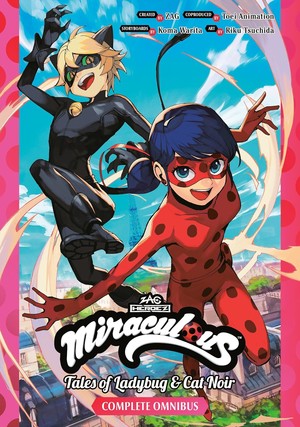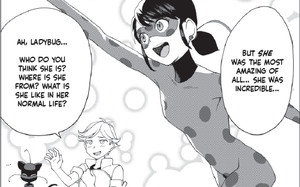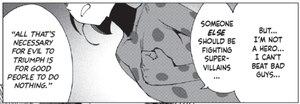The Fall 2025 Manga Guide
Miraculous: Tales of Ladybug & Cat Noir Complete Manga Omnibus
What's It About?

Marinette is your typical high school student: cheery and a little clumsy. Not so typical? She can transform into a superhero! As the confident, masked Ladybug, Marinette guards the streets of the City of Lights alongside Cat Noir, another superhero who, unbeknownst to Marinette, is her classmate Adrian, and her crush! Adrian doesn't know who Ladybug is, either, but he's crushing on her, too. Supervillains, school, and criss-crossed crushes? As if being a teenager and a crime-fighting superhero wasn't enough!
Miraculous: Tales of Ladybug & Cat Noir Complete Manga Omnibus has art by Riku Tsuchida and story by Koma Warita. English translation is done by Alethea & Athena Nibley, and lettering by Lys Blakeslee, and published by Kodansha Comics (November 4, 2025). Rated E.
Is It Worth Reading?
Rebecca Silverman
Rating:

Wakfu may be my favorite French cartoon, but it's still hard to argue with Miraculous Ladybug - it's a Saint Tail-flavored superhero delight, and that's something that this omnibus of the first three manga volumes captures very nicely. That said, you really do want to be at least a little familiar with the original show, because while volume three does go over how Marinette and Adrien become Ladybug and Chat Noir (I'm sorry, the English “Cat Noir” really bugs me) in the first place, the rest of the omnibus really does assume that you know who everyone is and what's going on. It's not impossible to pick up, but it's still a barrier to entry.
If you're not familiar with it, the story follows two French teenagers who are able to transform into superheroes to fight the depredations of the villainous Hawkmoth, who, for unspecified reasons, is out to “akumatize” people and make them evil. Marinette and Adrien fight as Ladybug and Chat Noir, respectively, granted their powers by their “kwami,” little fey beings who function like a magical girl's mascot character. It's got more in common with magical girls than superhero stories like My Hero Academia, right down to the arrangement most often seen in mysterious thief stories, where their secret identities are their own rivals in love. More specifically, at this point in the series, Marinette is in love with Adrien, who is in love with Ladybug, unaware that they're fighting crime together.
Two of the three books that make up this omnibus are basic crime-fighting adventures that fit into the animated series somewhere in the middle, before anyone knows Hawkmoth's real identity. Various school friends and acquaintances are akumatized, Adrien has birthday drama with his distant father, and Chloe is a total bitch to everyone who isn't Adrien. (Chloe is easily one of the most annoying and yet realistic teenage mean girls I've come across in fiction.) The art captures the scope of the cartoon's action scenes, particularly in terms of the heroes' flexibility, although there's something a little off about the way Ladybug is drawn in her spandex supersuit. Pelvises are not the artist's strong suit. But the multicultural look of the show is nicely captured, and if the Eiffel Tower is used in nearly every chapter, giving the impression that that's how the artist is saying “This is Paris!!” to the readers, it's forgivable for the sheer fun of the book.
I'd still recommend the original show over the manga. That's not because this isn't good, but rather because it clearly feels like a companion piece. I still enjoyed reading it, though, and I also appreciate the slight change-up in the way the translation notes were presented for a younger (chapter-book-to-middle-grade) audience; they're “special notes” rather than “translator's notes.” If you're already a Ladybug fan, it's worth picking up.
Erica Friedman
Rating:

Miraculous: Tales of Ladybug & Cat Noir Complete Manga Omnibus is a complete three-volume set of the Japanese comic adaptation of a cartoon made and set in France, translated into English. I love this kind of multilingual mishigas, and this series has all the positives and negatives of a comic for the younger side of young adults—repeated gags, monsters of the day, and a complicated, unresolved love polygon between the leads and their superhero alter egos.
Marienette is relatably average, who comes complete with a friend who captures everything for posterity and a built-in bully who doubles as a damsel in distress. We learn that she's earned her confidence as Ladybug and, partnered with Cat Noir, they are an unstoppable team. Adrien, being the rich and famous character, is very much less realistic, but his father's toxic doting on him feels like something we can understand.
The story underestimates its audience a bit, with Adrien and Marienette not being able to figure out their respective personas…or that of the evil Hawk Moth, which seems really obvious even before we're told who he is. So I'd say elementary readers might find this amusing, but it might be a little too cutesy for middle-grade readers. On the other hand, Precure fans might want to snuggle in and savor the Akuma du jour, which fall into a familiar pattern of dashed hopes and dreams turned into rampaging monsters that threaten all of Paris.
The true fun comes in watching Ladybug and Cat Noir combining their skills with the specific goal of saving the onlookers, people who have been captured, and their classmates who have been “akumatized,” then executing that with panache. Miraculous is a fun, fast-moving, but going nowhere in particular, story that is best read a chapter at a time to avoid gag repetition fatigue.
Bolts
Rating:

Miraculous Ladybug is a fairly interesting French cartoon with various influences and parallels to Japanese anime. Adapting the series into a manga seems like a no-brainer, but how well does the manga format capture the series's episodic, magical girl-inspired style? Unsurprisingly, it adapts rather well to the point where I would almost argue that this format matches many elements of the original series better than the CG animation.
It's actually easy to make that comparison, considering that at least one of the stories in this manga is a direct adaptation of episodes from the show. The structure is essentially the same, but some elements are cut, and the pacing is noticeably faster to match the new format. Some gags are cut out, such as Marinette's obsession with Adrian being toned down, and the action scenes are slightly retooled. The art style is able to fully capture the series' original aesthetic while also leaning into more exaggerated movements and facial features. Every chapter has a solid beginning, middle, and end, except the last one, which has a surprisingly strong cliffhanger for later volumes.
The drawback to this manga is that it still tries to act as an introduction to the whole franchise, and therefore, the first story is frontloaded with some of the most awkward exposition I think I've read in a long time. It's literally just a side character explaining where everybody is to the characters involved, and it is far from graceful. Also, while I did say the manga's artistic style captured much of the original charm, some scene transitions felt awkward. There are moments when a character gets knocked away, and the next page moves them to what seems like an entirely different scene. It felt like there were moments when panels were missing in an already abridged fight; the scenes felt a little more chaotic than I think they were supposed to. Overall, I think this is a solid introduction to the Miraculous Ladybug series. It's suitable for all ages and might even get you to check out the cartoon, even though that feels like a different beast entirely.
The views and opinions expressed in this article are solely those of the author(s) and do not necessarily represent the views of Anime News Network, its employees, owners, or sponsors.
discuss this in the forum (22 posts) |
back to The Fall 2025 Manga Guide
Seasonal homepage / archives